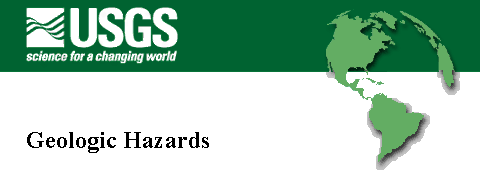
PRE-1980 TEPHRA-FALL DEPOSITS ERUPTED FROM MOUNT ST. HELENS, WASHINGTON
By Donal R. Mullineaux
U. S. Geological Survey Professional Paper 1563
Tephra Set Y
Set Y consists of three thick layers of pale-brown to yellowish-gray, well-sorted
pumice lapilli and bombs and interbedded ash that are overlain by a series of thin ash deposits. Near the volcano,
the set typically is 100-200 cm thick and comprises many thin ash strata enclosing one or more looser, thick layers
of coarse pumice. Toward the northeast, the set consists mostly of a single layer (Yn) of lapilli and bombs and
numerous thin ash beds (fig. 34). Toward the east and southeast (fig.
35), it also consists of a single lapilli layer (Ye) among beds of chiefly ash and thins from east around to
the southeast.
|
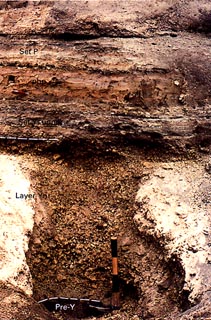
Figure 34. Tephra set Y 15 km northeast of Mount St. Helens. Layer Yn, the oldest layer identifiable
here, is almost 100 cm thick. The overlying strata of the upper part of set Y, ash bed pbp, and set P are each
20-25 cm thick. Tape bands on pickhandle are 10 cm wide. Photograph taken in 1989. (151K)
|
|
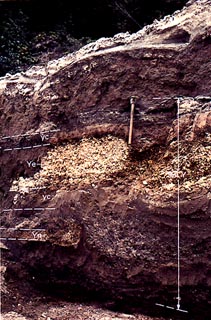
Figure 35. Tephra set Y about 8 km east of Mount St. Helens (measured section Y-1). Layer Ye, about 45
cm thick here, is both underlain and overlain by ash bed yc of flowage origin. Photograph taken in 1983. (126K)
|
A weakly oxidized zone that typically contains carbonaceous material marks
the top of the lower part of the set (fig. 36). Radiocarbon dates indicate that the
oxidized zone formed in no more than a few hundred years.
|

Figure 36. Composite columnar section of tephra set Y, Mount St. Helens. (21K)
|
Tephra layers in this set are interbedded with lenticular, locally thick deposits
of pumiceous and lithic ash probably deposited by pyroclastic flows, surges, and ash clouds.
Composition
Highly vesicular pumice from bomb to ash size makes up most of the thickest
layers Yn and Ye; smaller deposits contain more lithic particles. Ferromagnesian mineral suites in pumice from
all layers consist almost entirely of cummingtonite and hornblende; however, small amounts of biotite are common
in the basal layer. Sparse hypersthene, which may not be primary, was found in samples from a few stratigraphic
horizons.
Four of five samples of set Y pumice analyzed chemically contained between
65 and 66 percent SiO2; the fifth, from the uppermost part of the set, contained about 69 percent SiO2.
Diagnostic features
Set Y is distinguished from all other tephra deposits from Mount St. Helens
younger than set S by abundant cummingtonite and is less weathered than older cummingtonite-rich deposits. It is
also lighter colored than the underlying set J and much thicker and coarser than the overlying set P. Its color
and typical assemblage of coarse pumice layers interbedded with ash beds generally are adequate to identify the
set in the field.
Stratigraphic relations
Set Y typically directly overlies the weathered upper part of set J, although
colluvium and Mazama ash are present locally between those two sets. Near the volcano, set Y is overlain by set
P. The thin-bedded upper part of set Y is similar in grain size and thickness to set P, but the two are separated
by the ash bed pbp.
Distribution and thickness
Set Y is conspicuous from the north clockwise around to the south flank
of the volcano. From north to east around the volcano, at distances of about 10 km, the set as a whole is 50-150
cm thick (fig. 37); it commmonly has a thin, coarse layer at its base and a thicker
coarse layer higher in the set. It is thickest toward the north-northeast along the path of layer Yn, where the
set is more than 100 cm thick at 20 km and as thick as 50 cm at 100 km. Both of the two thickest layers and the
largest number of identified strata are present toward the east-northeast, although the set is only about 100 cm
thick at 10 km in that direction. Toward the east along the axis of layer Ye, the set is about 50 cm thick at 10
km and about 10 cm thick 100 km. Deposits of set Y are present west of Mount St. Helens, but no specific layers
were identified. Tephra of the set that was carried westward is mostly obscured by ash of flowage origin that dominates
the stratigraphic interval of set Y there.
|
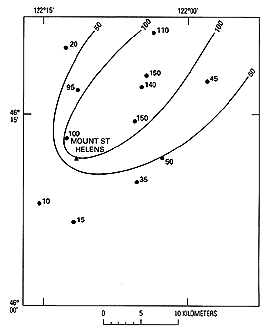
Figure 37. Approximate thickness in centimeters of tephra set Y, Mount St. Helens. Thickness reported
is cumulative thickness of strata interpreted as tephra; most stratigraphic sequences also include interbedded
deposits of probable flowage origin. (11K)
|
Age
Set Y was erupted between about 4,000 and 3,000 years ago. The older limiting
date is provided by radiocarbon dates of approximately 3,900 (W-2677) and 3,850 (W-3911) years B.P. (table
2), obtained from charred plant material at the base of the set. Charcoal samples from a pyroclastic-flow deposit,
an ash-cloud deposit, and a lahar, all of which are interbedded with tephra near the top of the set, were dated
at about 3,380 ((W-3144) (table 2), 3,350 (W-2549), and 3,280 (W-3262) years B.P., respectively
(Crandell and others, 1981). The oldest limiting date above the entire set is provided by charred wood fragments
from the base of the overlying set P, which were dated as about 2,960 (W-2675) years BP (Crandell and others, 1981)
(table 2). Enough time passed for vegetation to became established between eruptions
of sets Y and P, but no evidence is available to indicate whether the interval between them was only a few years
or was the few hundred years allowed by the radiocarbon dates.
In Canada, one ash layer identified as tephra of set Y has been reported as
4,300 or 4,400 years old. That tephra is mineralogically and chemically similar to layer Yn; its age was based
on an estimate of the sedimentation rate of peat between radiocarbon ages of about 3,800 and 6,500 years (Westgate,
1975, 1977). A review of evidence near the volcano, including a search for a part of set Y older than that now
recognized, failed to support the existence of a Yn-like layer below the base of set Y at the volcano. An alternate
explanation for the postulated 4,300-year-old bed is that it is layer Yn itself. A tephra layer identified as layer
Yn and dated at about 3,500 years B.P. has been found nearby (Westgate and others, 1970), but nowhere have two
Yn-like layers been found superposed. Moreover, the mineralogical and chemical compositions of the postulated older
Yn-like bed and layer Yn itself are reported to be too similar to distinguish between them (Westgate, 1977). Thus,
only the estimated rate of sedimentation indicates the presence of two similar but separate beds, and alternately,
there may be only one bed. Here, the postulated 4,300-year-old bed is regarded as layer Yn.
Previous names and correlative units
Set Y of this report is a major component of the "older pumice"
described by Carithers (1946).
Description of layers
Set Y can usefully be subdivided into lower, middle, and upper parts which
are present in large areas east of the volcano (figs. 36, 38).
The lower part consists of layers Yb and Yd. It is topped by a thin oxidation zone and carbonaceous material, which
represent a dormant period long enough for plants to have become established. The two thickest layers Yn and Ye
and interbedded ash make up a relatively coarse middle part of the set. The upper part, in contrast, consists of
many thinner and finer layers of ash and small lapilli.
|
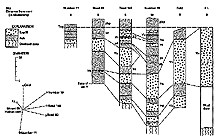
Figure 38. Columnar sections of tephra set Y from northwest to south of Mount St. Helens and diagram
of their locations relative to the central vent of the volcano. (28K)
|
Measured section Y-1
West valley wall of Smith Creek, at west end of bridge that crossed Smith Creek in 1983, in NE1/4
SE1/4 sec. 5, T. 8 N., R. 6 E. See Figure 35.
| |
|
Thickness
(centimeters) |
| 14. |
Ash bed pbp |
|
| Set Y |
|
|
| 13. |
Layer Yu |
|
| |
Ash, fine and coarse, lithic-rich: locally contains granules and small lapilli
|
1-2 |
| |
Ash and small lapilli: most lapilli are lithic
|
0.5-1 |
| |
Ash, fine and coarse, gray, lithic: coarsest in middle
|
2 |
| |
Ash and small lapilli, pumice and lithic, bedded
|
1-2 |
| |
Ash, fine to coarse, lithic and some pumice, gray
|
2 |
| 12. |
Layer Yo. Lapilli, small, lithic, gray, angular, in sparse ash |
3 |
| 11. |
Ash bed yp |
0.5-1 |
| 10. |
Lapilli (pumice and lithic) in ash: contains clasts as large as 7 by 5 by 3 cm: probable flowage deposit |
4 |
| 9. |
Layer Yf. |
|
| |
Ash, fine, compact
|
3 |
| |
Lapilli, small, mostly lithic, in coarse ash
|
4 |
| 8. |
Ash bed yc. Fine, compact: grayish-brown overlies pinkish-brown ash |
5 |
| 7. |
Layer Ye. |
|
| |
Ash and small pumice lapilli, brownish-gray, compact
|
2-5 |
| |
Pumice lapilli and small bombs
|
32 |
| |
Small lapilli and ash
|
3 |
| |
Pumice lapilli and small bombs
|
6 |
| 6. |
Ash bed yc. Ash, grayish-brown, compact |
7 |
| 5. |
Ash, gray, fine and coarse; small lapilli; bedding contorted; probable flowage deposit |
35 |
| 4. |
Layer Yn. Pumice lapilli, small, well-sorted |
10 |
| 3. |
Layer Yd |
|
| |
Ash, fine: upper 2 cm bleached gray, carbonaceous material at top
|
25 |
| |
Ash, coarse, and lithic; some pumice lapilli
|
2 |
| |
Ash, interbedded fine and coarse
|
4 |
| |
Ash and small lapilli, mostly lithic: scattered pumice
|
2 |
| |
Ash, fine, brown
|
1 |
| 2. |
Layer Yb |
|
| |
Ash and lapilli, crudely bedded, lithic (most abundant) and pumice (largest) |
5 |
| Below set Y |
|
|
| 1. |
Colluvium, brown: consists mostly of set J material |
>10 |
Layer Yb
Layer Yb consists of several poorly defined beds of pale-yellow to brownish-gray
pumiceous lapilli and bombs at the base of the set (fig. 39). The number and distribution
of individual beds are not known. The layer is thickest toward the north and northeast; toward the northeast, four
beds or coarse zones are present 5 km from the volcano. Most pumice in this layer is denser than that in other
major layers of set Y; only a small proportion of pumice clasts is highly vesicular. Cummingtonite and hornblende
make up almost its entire ferromagnesian mineral suite, but small amounts of biotite are common. A single, whole-rock
chemical analysis of layer Yb shows 65-66 percent SiO2.
| Figure 39. Tephra set Y, Mount St. Helens. |
|

Figure 39A. Multiple coarse beds in layer Yb about 5 km northeast of the volcano. Shovel lies on oxidized
top of set J. (209K)
|
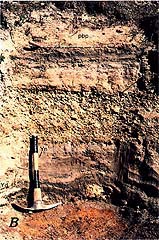
Figure 39B. 11 km due east of the volcano. Pick head lies on oxidized top of set J. Layer Yb consists
of scattered lapilli and a few bombs in ash overlain by a few centimeters of coarse and fine beds of layer Yd and
finer ash of undetermined origin. Layer Yn consists of only about 1 cm of pale-brown ash. Knife is at top of set
Y. (120K)
|
Layer Yb is identifiable chiefly as the basal coarse pumiceous unit of set
Y. Its ferromagnesian mineral content distinguishes it from the underlying set J, but without stratigraphic control
it is difficult to distinguish from other strata in set Y. Relatively dense pumice and biotite content are the
most useful criteria to make that distinction. In addition, electron-probe analyses of ash from Canada (Westgate,
1977) and from a site 50 km southeast of Mount St. Helens (Mack, 1980) suggest that chemical differences might
distinguish layer Yb from other layers of set Y. Samples from stratigraphically confirmed layers at the volcano,
however, were not analyzed to test that possibility.
Typically, layer Yb lies directly on the weathered upper part of set J, although
in a few places it lies on colluvium or Mazama ash. It is overlain throughout its known extent by younger layers
of set Y.
Layer Yb was identified from slightly west of north of the volcano clockwise
around to slightly south of east. At 10 km to the north, it consists of lapilli and ash 20-25 cm thick. At 5 km
due northeast, it consists of as many as four coarse zones or beds of lapilli in a 35-cm-thick deposit (fig.
39A). East of the volcano, it is much thinner, consisting of scattered lapilli and even a few bombs in a few
centimeters of ash at distances of 10-15 km (figs. 39B, 40).
|
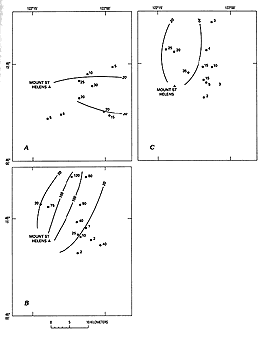
Figure 40. Thickness (in centimeters) of layers in tephra set Y, Mount St. Helens. A, Layer Ye. B, Layer
Yn. C, Layer Yb. (15K)
|
Farther downwind, ash beds that probably are parts of layer Yb are present 50 km north of Mount St. Helens at Davis
Lake (Barnosky, 1981), 80 km to the northeast in Mount Rainier National Park (Mullineaux, 1974), and 50 km to the
east (Mack, 1980). At one time, only one pumice bed below layer Yn was thought to be extensive (Mullineaux and
others, 1975), but these widespread occurrences show that multiple beds are present, and that they extend far downwind
in very different directions.
Several radiocarbon samples about 3,900 years old were recovered from immediately
below layer Yb (samples, W-3911 and W-2677, table 2), and layer Yb underlies radiocarbon
dated at about 3,500 years old (sample W-1752, table 2). The time required to develop
an incipient soil that is above layer Yb but below the 3,500-year-old samples suggests that the age of layer Yb
is close to 3,900 years.
Layer Yd
Layer Yd is composed of at least 14 beds of moderately vesicular to nonvesicular,
well-sorted lapilli and ash (fig. 41). Near the volcano, beds of lapilli alternate
with coarse ash in a sequence of highly similar strata. The layer is coarse and thick only close to the volcano,
but thin ash of the layer is widespread east of the cone. Cummingtonite and hornblende are the only abundant ferromagnesian
minerals in the layer.
|

Figure 41. Alternating coarse and fine beds in layer Yd 7 km northeast of Mount St. Helens. All the beds
shown are parts of layer Yd. Shovel head, about 25 cm long, is shown for scale. Photograph taken in 1979. (149K)
|
A thin soil profile, consisting of scattered carbonaceous fragments in a bleached
zone that overlies a weakly oxidized zone, has been developed in the upper part of the layer.
Layer Yd is recognized chiefly by its multiple similar beds, relatively dense
yet vesicular fragments, thin soil at the top, and stratigraphic position between layers Yb and Yn.
The thickest and coarsest part of layer Yd extends east-northeast. It contains
abundant lapilli and is as thick as 60 cm 5-6 km from the volcano and as thick as 40 cm at 9 km. Toward the east,
it is about 20 cm thick but consists almost entirely of ash. Ash of layer Yd probably also extends to the southeast
but was not differentiated from ash of layer Yb. Ash in the stratigraphic position of the two layers is about 20
cm thick 8 km southeast of the volcano. Layer Yd is probably more widespread than is now known, but it was not
traced elsewhere around the volcano or farther downwind.
Similar to layer Yb, layer Yd is younger than 3,900 years and older than 3,500
years, and its age also probably is close to the 3,900-year date.
Layer Yn
Layer Yn (figs. 34, 36)
is a deposit of mostly lapilli and bombs of highly vesicular, pale-yellow or brown pumice that is 100-200 cm thick
at the northeast base of the volcano. It is the coarsest, thickest, and most voluminous single pumice layer in
set Y, and one of the most voluminous ever erupted by Mount St. Helens. Its pumice contains only cummingtonite
and hornblende as ferromagnesian phenocrysts, and hornblende overgrowths on cummingtonite phenocrysts are common.
Chemically, the pumice is similar to that of layers Yb and Ye; some data (Westgate, 1977), however, suggest that
glass in layer Yn is slightly more silicic than glass in Yb.
Along the north-northeast-trending axis of its lobe, layer Yn is readily identified
because it is the thickest and coarsest pumice of any age. Its pumice generally is firmer than that in older coarse
layers, and its yellow color distinguishes it from younger coarse pumice units. Its ferromagnesian mineral suite
readily distinguishes it from most layers in set S by the absence of hypersthene and from all other tephras younger
than set S by the presence of cummingtonite.
Near the volcano, layer Yn overlies an incipient soil at the top of layer Yd.
It is overlain by younger layers of set Y, although at the east and northeast base of the cone, ash-cloud deposits
are between it and the younger deposits.
On the volcano, layer Yn generally is buried by younger deposits. Beyond the
volcano, it forms a thick lobe that extends north-northeast (fig. 40). Along its lobe
axis, the layer consists of as much as 200 cm of lapilli and bombs at a distance of 5 km, and it is about 100 cm
thick at 15-20 km. Its thickness decreases to about 20 cm at 100 km and 5 cm at 250-300 km (Mullineaux, 1977).
North of the volcano, layer Yn consists of lapilli and bombs but is only 20-30 cm thick at 10 km.
Layer Yn thins abruptly along the western margin of its lobe but thins and
fines gradually along the eastern edge to a obscure deposit of thin ash. At 11 km directly east of the volcano,
1-2 cm of ash makes up the entire layer.
Layer Yn is one of the most important marker beds of Holocene age from Mount
St. Helens. In Mount Rainier National Park, it is slightly more than 30 cm thick at a distance of 80 km (Mullineaux,
1974), and it can be identified as far as 900-1000 km from Mount St. Helens (Westgate and others, 1970).
The layer is about 3,500 or 3,400 radiocarbon years old. A review of radiocarbon
dates available in 1973 (Mullineaux, 1974) suggested the age to the closest hundred years is 3,400 years. A recent
review (Vogel and others, 1990), proposed a more precise age of 3,360 ± 65 years B.P. Because of the imprecision
of radiocarbon dates, either 3,400 radiocarbon years or the frequently used date of about 3,500 radiocarbon years
is reasonable for the age of layer Yn.
Layer Yn of this report was first identified at Mount Rainier and described
as layer Y (Crandell and others, 1962). Layer Yn in Mount Rainier National Park was described as "the major
pumice and ash layer from Mount Rainier" by Hopson and others (1962) and Fiske and others (1963).
Layer Ye
Layer Ye (figs. 35, 36)
is a pale-yellow-brown pumice lapilli and small bomb deposit that is as thick as 50 cm at the east base of the
volcano. It is very similar to layer Yn but less voluminous, and occurs only east and southeast of the volcano.
Although in most outcrops layer Ye appears to be a single shower bed, it locally exhibits two coarse zones (measured
section Y-1). The two coarse zones were seen only on slopes and may represent minor slumping during accumulation
rather than different eruptive pulses.
Layer Ye consists chiefly of highly vesicular pumice and contains only scattered lithic fragments. The ferromagnesian
mineral suite consists almost entirely of cummingtonite and hornblende. Whole-rock chemical analyses show that
layer Ye pumice is similar to pumice of layers Yb and Yn; however, some analyses by Westgate (1977) suggest that
differences in silica content of glass from the layers may be enough to distinguish each from the others.
Layer Ye is distinguished from layers Yb and Yn chiefly by stratigraphic position
and distribution. It differs from pre-Y cummingtonite-bearing pumice deposits east of the volcano by its firmer
pumice and absence of hypersthene and from coarse units in other Holocene tephra sets by its abundance of cummingtonite.
Close to the volcano, Ye overlies layer Yn or other layers of set Y, separated
by ash deposits of probable ash-cloud origin. It is overlain successively by more ash of probable ash-cloud origin
and thin tephras of the upper part of set Y.
Layer Ye was identified from about northeast of the volcano around to the south.
It is thickest and coarsest toward the east (fig. 40). At a distance of 8-10 km in that direction, it consists
mostly of lapilli and is as thick as 40 cm. In contrast, it is only 1-2 cm thick at 8 km directly toward the northeast
and only 5-10 cm thick at 8 km directly toward the southeast.
Layer Ye forms a readily identified marker bed downwind; it is the main Holocene
cummingtonite-bearing tephra east and east-southeast of the volcano. Layer Ye presumably is the "Y-like"
cummingtonite-bearing ash bed reported to be 2-7 cm thick at a distance of 400 km in northeastern Oregon (Norgren
and others, 1970; Borchardt and others, 1972).
Layer Yf
At least five separate thin beds of ash and small lithic and pumice lapilli
are grouped as a layer termed Yf (fig. 42). This group has been recognized separately
only close to the volcano toward the northeast and east, mainly in the Smith Creek valley. Locally, bedding is
obscure and some beds are lenticular. Ferromagnesian minerals from all pumice lapilli sampled consist almost entirely
of cummingtonite and hornblende. Deposits of layer Yf appear virtually unweathered; a thin, oxidized zone near
their base probably is a result of deposition from ground water rather than surface oxidation.
|

Figure 42. Layers in upper part of tephra set Y, Mount St. Helens, 8 km northeast of the center of the
volcano. Pocketknife shown for scale. Photograph taken in 1977. (155K)
|
Layer Yf is similar to other deposits in the upper part of set Y and is identified
primarily as a sequence of thin, fine beds in its stratigraphic position; it is the lowest group of thin tephra
beds above layer Ye. It is separated from layer Ye in some places by the ash bed yc and in other places by ash
bed ya or its associated pyroclastic-flow deposit. Layer Yf is overlain by the distinctive ash bed yp.
Layer Yf was identified from northeast to east of the volcano, where it is
15-20 cm thick at distances of 8-10 km. The stratigraphic interval that contains the layer, however, is locally
as much as twice that thickness because of interbedded ash of probable flowage origin. Although layer Yf surely
extends beyond the sites at which it was identified, no attempt was made to trace it.
Layer Yo
Layer Yo is a single, well-sorted bed as thick as 6 cm of gray ash and small
lapilli (fig. 42) northeast and east of the volcano. It consists mostly of fresh lithic
fragments and contains small amounts of moderately vesicular pumice. Cummingtonite and hornblende are the only
abundant ferromagnesian minerals in the layer, but sparse hypersthene is common.
Layer Yo is thin, but better sorted, more friable, and more dominantly lithic
than other described layers in the upper part of set Y. It is approximately in the middle of the upper part of
set Y, immediately above the thin, pinkish brown ash yp and below several other thin beds in the uppermost part
of the set.
Layer Yo was identified mainly in the Smith Creek valley from about northeast
to east of the volcano. At 8-10 km from the volcano in those directions, it commonly consists of ash and small
lapilli as large as 1 cm across, and it is 2-6 cm thick.
This layer is described as tephra because of its continuity and gradual changes
of thickness and grain size over a distance of several kilometers. Locally, it is similar to the stratigraphically
lower ash-cloud bed ya, but it is more consistent in thickness and texture than bed ya and lacks the charred wood
that is typical of bed ya.
Layer Yu
Layer Yu consists of as many as six poorly stratified, poorly defined thin
beds of coarse ash and small lapilli (fig. 42) and makes up the uppermost part of set
Y northeast and east of the volcano. These strata are planar bedded and lack crossbedding. Layer Yu consists mostly
of somewhat vesicular to lithic fragments but contains some highly vesicular pumice. Ferromagnesian mineral suites
in the various beds consist chiefly of cummingtonite and hornblende and typically include small amounts of hypersthene
and oxyhornblende.
No diagnostic features were identified for this layer nor were any of its beds
traced individually. It is defined as the lapilli-bearing tephra deposits of set Y that overlie layer Yo. Layer
Yu is overlain directly by the ash bed pbp and in turn by tephra of set P.
Layer Yu is relatively consistent in grain size and thickness for a distance
of several kilometers from northeast to east of the volcano but was noted separately from other parts of set Y
only in that sector. At 9 km northeast of the volcano, it is about 15 cm thick and contains at least six distinguishable
beds. At 8 km to the east, the layer is 5-10 cm thick and contains at least four identifiable beds.
Deposits of probable flowage origin associated with set Y
Abundant ash deposits, produced at least in part by flowage phenomena, are
interbedded with and immediately above set Y. Four such ash deposits that are distinctive, locally thick, or areally
extensive are described herein because they are useful stratigraphic markers.
Ash Bed yc
Ash bed yc consists of fine to coarse, brown to gray ash that locally is
thick and probably consists of several depositional units. It lies directly on tephra layer Yn and is both below
and above layer Ye (figs. 35, 36). It consists chiefly
of glass, and ferromagnesian mineral suites are composed mostly of cummingtonite and hornblende, and lesser amounts
of hypersthene and oxyhornblende. Ash bed yc is recognized by its grain size, variable thickness, and stratigraphic
position relative to layers Yn and Ye.
Ash bed yc was identified only in and near the Smith Creek valley northeast and east of the volcano. The thickest
known deposit is 8 km east-northeast of the volcano, where it is as thick as 40 cm. It thins rapidly away from
that area. Only about 3 km from that site, at both 9 km to the northeast of the volcano and 8 km to the east, the
ash is only about 20 cm thick.
Ash Bed ya
Ash bed ya consists of a single, friable stratum, from a few centimeters
to about 20 cm thick, of angular lithic fragments of moderate- to dark-gray ash and small lapilli. It is characterized
by abundant charred conifer needles and small wood fragments. Hornblende and probable altered cummingtonite make
up most of its ferromagnesian mineral suite. Its color, friable character, lithic content, and abundant charred
plant fragments distinguish this layer from other strata associated with set Y.
Close to the volcano on the northeast and east, ash bed ya lies above ash bed
yc (fig. 36). Ash bed ya is as thick as 20 cm but is less than 10 cm thick over most
of the area where it was found. It was identified as far as 10 km from the volcano toward both the northeast and
east.
Before 1980, a lithic pyroclastic-flow deposit that stratigraphically correlates
with bed ya was well exposed along Smith Creek about 8 km northeast of Mount St. Helens (Crandell, 1987). That
pyroclastic flow consisted of gray lithic fragments similar to those in ash bed ya, contained abundant charred
logs, and was overlain by the same beds of set Y as overlie ash bed ya. Ash bed ya is interpreted to be the deposit
of an ash cloud associated with that pyroclastic flow.
Ash Bed yp
A thin, pinkish-brown bed of fine ash (figs. 36,
42) that is widespread northeast of the volcano is designated ash bed yp. Although
widespread, it is nowhere known to be either coarse grained or more than about 2 cm thick. It consists chiefly
of glass particles, but no pumice lapilli have been discovered in it, even close to the volcano. Cummingtonite
and hornblende are its predominant ferromagnesian minerals, and oxyhornblende is abundant.
Although thin, ash bed yp is distinctive and can be recognized by its color,
thinness, and stratigraphic position in approximately the middle of the upper part of set Y (figs.
36, 42). The bed might be fine-grained tephra but is more likely to be ash that
drifted downwind in one or more ash clouds generated by pyroclastic flows. Close to and northeast and east of the
volcano, ash bed yp is an excellent stratigraphic marker in the upper part of set Y.
Ash Bed pbp
A faintly bedded ash deposit that separates set Y from set P is termed ash
bed pbp. This ash is widespread and as thick as 50 cm. At one site 8 km northeast of the volcano, it includes more
than 10 recognizable depositional units of fine vitric and lithic ash. The deposit is mostly brown but typically
is multicolored and commonly is reddish brown in both its lower and upper parts.
This ash deposit records a change in mineralogic character of material erupted
from the volcano. At its base, ferromagnesian mineral suites are dominated by cummingtonite and hornblende and
thus are similar to those in the upper part of set Y. Cummingtonite is less abundant higher in ash bed pbp, and
at the top of the bed hypersthene is more abundant than cummingtonite. Oxyhornblende is common, especially in the
upper and lower parts.
Ash bed pbp was found from northeast to south of the volcano. At 7-10 km to
the northeast and east, it commonly is 30-50 cm thick (fig. 43). At that distance east
of the volcano it commonly is only 10-20 cm thick.
|
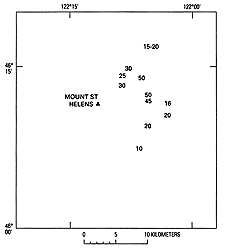
Figure 43. Thickness (in centimeters) of ash bed pbp, Mount St. Helens. (8K)
|
No individual lamina within ash bed pbp have been traced laterally, and how
widespread any specific one might be is not known. Features diagnostic of either tephra or ash-cloud deposits were
not seen, but both could be represented in this ash bed. The multiple beds and wide distribution of ash bed pbp
suggest that it consists of many overlapping depositional units.

